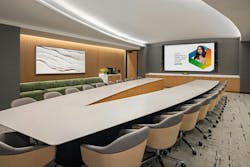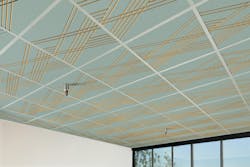Before Michael DiTullo became head of product innovation at Kirei, a division of Carnegie Acoustic Solutions, he was chief design officer at a consumer electronics audio company in Southern California. Among his responsibilities were corporate facilities, which included completely gutting and redesigning the company’s headquarters.
“I redesigned it with the vibe of a Bay Area startup, with concrete floors, glassed-in conference rooms, and bright-colored walls with roll-up glass doors to the outside,” he explained. “When everybody moved into the finished space, they said, ‘This place is amazing. It’s so cool!’”
One week later, he heard, “We hate working in here. We can't hear anything. Echoes are everywhere.”
“I lived the experience of creating a beautiful space, completely ignoring acoustics, and spent the next two years basically correcting the issues in every space in that building,” DiTullo noted. “People made it very clear how difficult it was for them to do their work. The noise was increasing their stress level, lowering their productivity, and increasing their distractions.”
Poor acoustics are prevalent yet solvable, and top of mind for facilities managers, particularly following the pandemic. As employees return to the office, efforts are underway to ensure unwanted noise doesn’t interfere with productivity and wellbeing. People may be more sensitive to noise after having worked from home in quieter settings. Also, offices are adding more collaborative spaces and new technologies for hybrid work, adding to noise levels.
“Hybrid work has completely reshaped how we use office space. We’re no longer just sitting at desks. We’re collaborating, video conferencing, and problem-solving in real time. Acoustics play a huge role in making those transitions seamless,” said Jason Bird, founder and creative/managing director of Luxxbox.
Facilities Managers Can Optimize the Ceiling
An effective method to help reduce unwanted noise is applying acoustic solutions to ceilings—often dubbed the “fifth wall.” Acoustic ceiling treatments are designed to absorb sound, preventing it from bouncing around the room and causing echoes.
Acoustic ceiling products continue to get better and easier to install, and today’s options can add a design element to enhance the space while lowering the noise. No longer plain, boring panels, today’s treatments include intriguing acoustic ceiling tiles (ACTs), baffles, clouds, and lighting. Acoustic ceiling treatments come in an array of colors, shapes, patterns, and fabrics that can either complement existing spaces or help imagine new ones.
“The solutions feel a bit limitless,” said Stephen Wells, principal at interior design firm Hendrick. “There's so much customization that’s possible within a lot of the systems. The world is your oyster when it comes to these applications, systems and options in today’s market.”
Additionally, selecting sustainable options like those made from recycled PET felt (derived from recycled plastic bottles), timber from sustainable forests, and natural wool fabrics provide effective noise control without compromising environmental responsibility. Many solutions also meet LEED, Fitwel, and WELL standards.
How Can Facilities Managers Choose the Right Treatments?
Acoustic ceiling treatments differ in placement, design, and how they absorb sound.
ACTs are installed within a grid system to cover the entire ceiling. Kirie recently debuted three new ACT products—Hatch, Sidebar and Gather—for commercial ceiling grids. DiTullo said ACT grids absorb unwanted sound in offices and conference rooms, but they often lack creativity, and alternative options are often more expensive.
He said Kirei’s new ACTs add color and texture—and with Kirei Ink printing—offer a selection of customized material options including wood grains and natural textures that not only enhance acoustic performance but elevate the look of the common ACT grid.
Additionally, Kirei products are made from 60% post-consumer recycled plastic.
Baffles and Clouds Hang from Ceilings
Differing from full ceiling treatments, baffles and clouds are installed in specific areas that need sound control. Baffles are vertically suspended panels, and clouds are horizontally suspended. Both can lower noise and create a focal point of interest.
“It’s taking acoustics and making it a design feature and not something that’s hidden within the walls or behind the ceilings,” explained Wells. “It’s obvious that it’s an acoustic material and what it's there for, but it can also be really cool or dynamic.”
Acoustic Lighting is Another Option
Architecture firm Cushing Terrell recently completed a redesign of its Denver office. It’s an open office designed to support hybrid work and utilized acoustic baffles, wall tiles, and Luxxbox’s sustainable, acoustic lighting solutions to help keep noise down while adding beautiful lighting and style.
In the breakroom, Luxxbox’s Georgina Acoustic Pendant has a delicate, floating quality, adding a soft touch to the room’s industrial finishes and creating space for employees to recharge. Georgina is made using noise-absorbing recycled PET felt.
In the lounge, the Waffle Pendant Downlit is a colorful disc-shaped acoustic panel for collaborative areas and blends with the room’s pastel tones and relaxed seating. The Waffle pendant is made from recycled PET felt and high-quality wool that’s responsibly farmed and biodegradable.
“Cushing Terrell’s design approach was all about balancing creativity, productivity, and comfort,” noted Bird.
Consider Acoustic Plaster
Wells used an acoustic plaster, which is also sustainable, for the first time for OneDigital’s new corporate headquarters in Atlanta. Hendrick was the project’s interior designer.
Hendrick installed barrel-vaulted ceilings in the reception area and boardroom and hired an acoustician to advise on the project. Installing acoustic plaster requires a high level of workmanship as it’s applied using traditional plastering techniques, with a layer of sound-absorbing materials, and a coating layer using special acoustic methods.
“It’s a true science to get it right,” Wells explained.
Experts say facilities managers should have an acoustics plan and budget—whether it’s for new or existing spaces. Meeting with an acoustics consultant can also be beneficial. Consultants can do assessments and measurements and provide recommendations for acoustic treatments and materials.
About the Author
Liz Wolf
Liz Wolf is a Twin Cities, Minnesota-based freelance business writer specializing in commercial real estate.



